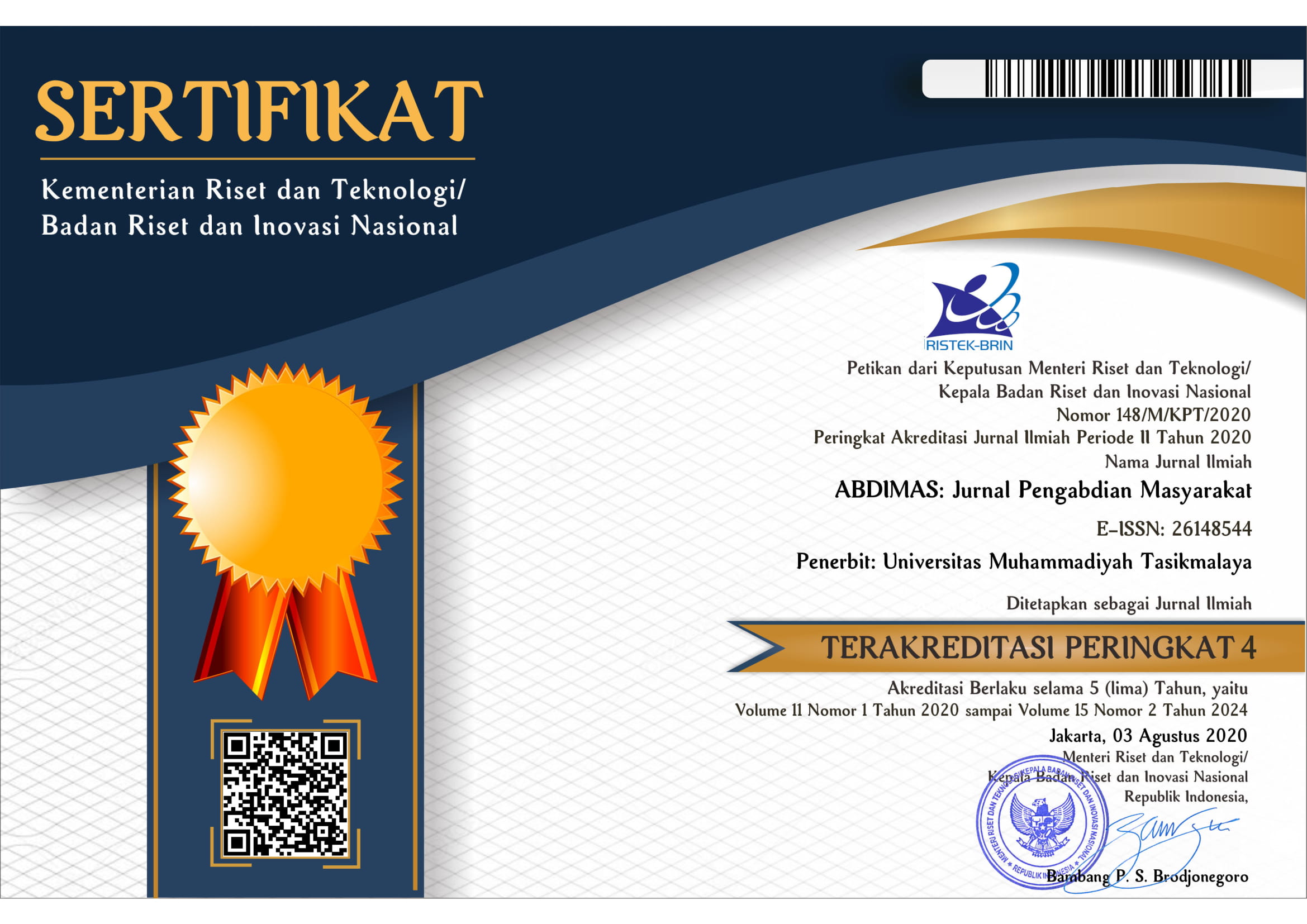Healthy Life Education for Students In Malaysia
DOI:
https://doi.org/10.35568/abdimas.v6i4.4135Keywords:
healthy life, hand hygiene, behaviorAbstract
Healthy living behavior is a reflection of a family lifestyle that always pays attention to and maintains the health of all family members. School-age children are a critical age group because at that age a child is vulnerable to health problems. In addition, school-age children are also in a condition that is very sensitive to stimuli so they are easy to guide, direct, and still have good habits, including healthy living habits. Children of this age also have the trait of always wanting to convey what they receive and know from other people. The results of observations made at the Kuala Langat Malaysia Guidance Centre still have a lack of healthy behavior. The conditions of the students were very diverse and the facilities were inadequate, because all classes, from grade 1 to grade 6, were made into 1 class. Washing hands with soap (Hand Hygiene) is one of the healthy living behavior in students. This is important for children who are vulnerable to both communicable and non-communicable diseases. The method of implementing community service is through education and the practice of washing hands with soap directly to students. The results show that students and teachers are very enthusiastic and follow every step practiced by the presenters. they were happy and practiced together after the activity was over. By providing education on healthy living, especially hand washing, it is hoped that teachers and students at the Kuala Langat Guidance Centre will have good and healthy habits.
Downloads
References
Adek, I. E., Ngurah, W. H. S. I. G., & AAN, O. S. G. (2021). Implementation Of Clean and Healthy Living Behavior Efforts to Prevent the Spread of Covid 19 Padang Sambian Kelod Village. ABDIMAS: Jurnal Pengabdian Masyarakat, 4(2), 844-852.
Andi. (2020). Perilaku Hidup Bersih dan Sehat (PHBS) pada Anak Usia Dini sebagai Upaya Pencegahan Covid 19. JEA (Jurnal Edukasi AUD), 6(1), 58–73
Alene, M., Tamiru, D., Bazie, G. W., Mebratu, W., & Kebede, N. (2022). Hand hygiene compliance and its associated factors among health care providers in primary hospitals of Waghimira Zone, Northeast Ethiopia: a mixed study design. Antimicrobial Resistance & Infection Control, 11(1), 1-9.
Chittleborough, C.R.; Nicholson, A.L.; Basker, E.; Bell, S.; Campbell, R. 2012. Factors influencing hand washing behaviour in primary schools: Process evaluation within a randomized controlled trial. Health Educ. Res. 2012, 27, 1055–1068. [CrossRef]
Desiyanto., & Djannah.2013.Efektifitas Mencuci Tangan Menggunakan Cairan Pembersih Tangan Antiseptik (Hand Sanitizer) Terhadap Jumlah Angka Kuman, Jurnal Kesehatan Masyarakat,Vol.2 No.2.
Handayani, Rina Tri et al. Pandemi Covid-19, (2020). Respon tubuh, dan herd immunity, Jurnal Ilmiah Permas, Sekolah Tinggi ilmu Kesehatan Kendal, volume 10 no 3
Kementerian Kesehatan. (2016). PHBS. http://promkes.kemkes.go.id/phbs. Levy ,M.R. (1984).Lyfe and health.New York:
Klar, K., Knaack, D., Kampmeier, S., Hein, A. K., Görlich, D., Steltenkamp, S., ... & Becker, K. (2022). Knowledge about Hand Hygiene and Related Infectious Disease Awareness among Primary School Children in Germany. Children, 9(2), 190.
Lismayanti, L., Falah, M., Budiana, I., Permana, A. R., Zakia, D. Y., Aditia, M. A., & Rosmiati, R. (2021). Implementation of Health Belief Models (HBM) Education for Tuberculosis patients at the Tamansari Primary Health Care, Tasikmalaya City. ABDIMAS: Jurnal Pengabdian Masyarakat, 4(2), 1452-1457.
Syamsidar, S., & Falah, F. (2022). Empowerment of Diabetes Self-Management Assistance Groups (DAG) as an Effort to Improve Self Care Behavior of Diabetes Mellitus Patients in Gorontalo City. ABDIMAS: Jurnal Pengabdian Masyarakat, 5(1), 1646-1650.
WHO. (2009). Guidelines on Hand Hygiene in Healthcare. Geneva: WHO
WHO. WHO guideline on hand hygiene in health care (Advanced Draft). World Alliance for patient safety. [Internet]. 2006. Available from: https:// apps.who.int/iris/bitstream/handle/10665/69323/WHO_EIP_SPO_QPS_ 05.2.REV.1_eng.pdf. [cited 2019 Dec 9].














